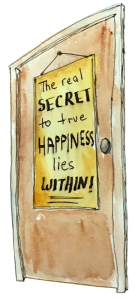Suffering is a valuable thing. Enjoy your life without rejecting problems or suffering…
The trick is knowing how to accept discomfort without being caught by it.
– Suzuki Rochi
One of the quickest ways to improve the quality of your mental and emotional experience is to learn how to effectively handle pain and suffering. The bad news is pain and suffering is a fact of life. From petty disturbances to major heartbreaks, we all get our fair share of life’s annoyances, disappointments and tragedies. The good news is that learning how to master these experiences can significantly improve your quality of life inside of yourself.
No matter how you respond to pain and suffering, you will get more. The goal is not to eliminate it, but to figure out how to use it as a stepping stone into something better. Since the days of the cavemen, humans have been hardwired to resist and pull away from pain — a great strategy to avoid getting eaten by a saber-tooth tiger. However, this autopilot response no longer serves us and needs to be rewired.
Nowadays, most of our suffering occurs in response to the frustrations and disappointments of everyday life, like standing in long lines, being caught in traffic or not getting the promotion you wanted. The scale of our mental and emotional suffering can escalate to being the victim of starvation, violence or terrorism. However, most of us don’t experience that. The height of our suffering might be heartbreak over the end of a marriage or the death of a loved one.
Consider what happens when you automatically respond to negativity with resistance. It’s like duct taping yourself to the source of irritation. What you resist persists because you are focusing upon it and thus giving it your attention and energy — you are fueling the fire. This is equally true whether you are escalating your irritation over a traffic jam or caught in endless sorrow over the loss of a loved one. In both cases, you are attaching yourself to the source of your distress and not integrating the experience. I am not suggesting that one should “get over it” when a loved one dies. Grief has a natural life of its own. However, sometimes people are unable to move on.
There are three steps to mastering your experiences of pain and suffering. The first is to notice what your instinctive response is when negativity comes up inside of us. Rather than focusing on the source of your distress, pay attention to your response to it. Do you try to dissipate the energy by exploding — for example, blaming and judging others? Or do you implode? Do you silently suffer as you stuff the distress back down inside of yourself through addictive behaviors like compulsive eating, or drinking or spending? Pay attention. Observe your own pattern of response.
The second step is to breathe into the experience of pain and suffering. Build your tolerance so you can stay present in the moment. This will give you the opportunity to buy a little time to make different choices. Instead of unconsciously doing what you have always done, study your patterns, lean into them, get intimately familiar with the sequence of events that cause a minor disturbance to escalate into a learned response and then a repetitive pattern and so on. How do you do it? How do you go from being just fine to being in a rage or falling into a depression? Does your energy cycle up and out or in and down?
The third thing is to do something different. You might wonder why not just do that first? The reason is that the first two steps are what create your willingness and ability to change your behavior. You have to first know where you are and that you don’t want to stay there before you are going to effectively and creatively find and build other responses to the negativity in your life. You need to develop response strategies that lift you up rather than swirling you into a rage or a downward spiral.
Let’s use the example of being stuck in traffic. Some people have so little control over their mental and emotional behavior that they allow this irritation to escalate into road rage. It goes something like this: “Not this again. I’m sick and tired of this. I wish these people would just get out of my way. Look at that idiot.” And so on. The energy spins and feeds on itself and the driver probably experiences an elevation of blood pressure. Here’s the alternative:
Step One — Notice Your Response: “Whoops, here I go again. I hate this traffic.”
Step Two — Lean Into Your Experience: “Every day it’s the same thing. As soon as I get to Route 92, I’m in for at least a 20 minute delay and I get hot under the collar. It shouldn’t be this way. I don’t like this. I feel trapped.”
Step Three — Do Something Different: “When I get home, I’m going to see if I can find another route home. For now, I’m going to think about where I would like to go for vacation this year. Let’s see … Tuscany? The Bahamas?”
This three step process may be a little less obvious with an experience that spreads out over time like the loss of a loved one. However, it works the same way. In order to change your response, you must first notice what your pattern of response actually is, then breathe into it and really take ownership of what you are doing. Finally, intentionally try something different.
With practice, you will find yourself mastering the art of recovering faster with less drainage of your energy and less creation of negativity. See how fast you can get back in balance with yourself. This is not a game of pretending nothing ever happened. Rather, it is a matter of developing the art of recovery.
If you would like to know more about me and my work, please explore my website here.
Also, if you know anyone who might get value from this article please email or retweet it or share it on Facebook.






